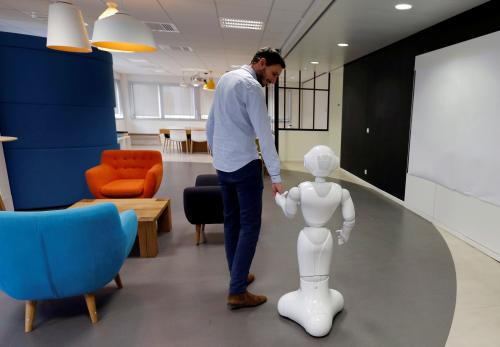Executive Summary
The Refund to Savings (R2S) initiative, a product
of a unique collaboration among partners
from academia and industry, seeks to improve
the financial security of low- and middle-income
(LMI) households by promoting saving of federal tax
refunds. Researchers from Washington University
in St. Louis and Duke University have worked with
Intuit, Inc., the maker of TurboTax software, to
design and test scalable interventions that encourage
tax filers to save a portion of their federal tax
refunds and that streamline the process of depositing
refunds directly to savings vehicles. These computer-based interventions are low cost and low touch;
that is, only a minimal investment of personnel
is required to deliver the interventions to great
numbers of people.
The annual occasion of filing taxes (“tax time”)
presents a unique opportunity to encourage and
facilitate saving behavior at a time when people
anticipate receiving lump sums—tax refunds—beyond
usual income. In 2013 (tax year 2012), approximately
680,000 refund-eligible tax filers participated in
the R2S experiment, which Intuit embedded in
TurboTax Freedom Edition (TTFE), the tax-preparation
software that Intuit offers for free to qualified LMI
households. The experiment’s randomized controlled
design enables rigorous evaluation of a variety of
interventions to increase the number of savers and
the dollar amounts saved. This report presents results
from an evaluation of R2S interventions in 2013.
Principles of behavioral economics informed the content
of messages and the format of these interventions. In
addition, the experiment was designed to make saving
a salient default option. We tested two main behavioral
mechanisms in varying combinations throughout the
2013 tax-filing season: (a) motivational prompts and (b)
suggested savings amounts (anchors).
Six primary research questions are addressed by the R2S
experiment:
Can behavioral economics techniques increase
the number of people who deposit to savings at
tax time?
- Can R2S encourage filers to split their refund,
allocating a portion to savings -
Does R2S increase the amount of money
deposited into savings at tax time? -
Do R2S interventions increase the number of
people who save their refund for 6 months? -
Can R2S increase the proportion of refund saved
6 months? -
What can R2S administrative and survey data tell
us about the financial lives of LMI households?
Data for this evaluation come from two sources. Data
on income, tax credits and deductions claimed, tax refund amount, and the participant’s chosen method
for receipt of the refund (e.g., via direct deposit into
a savings account) are collected by the TTFE software.
This information is complemented by data from two
waves of a survey administered by the researchers.
Immediately after submitting their tax returns, 20,816
filers responded to an invitation to take a detailed
Household Financial Survey, which thoroughly examined
assets, liabilities, intended use of tax refunds,
product preferences, behavioral characteristics, and
demographic traits. Six months later, 8,484 of those
respondents participated in the second wave of the
survey and reported on their actual use of the refunds.
Data from the longitudinal survey also offer useful
insights into the financial lives of LMI households.
It is important to understand the context in which
those households are trying to save and the methods
of coping with contingencies when savings are not
available. Such knowledge is key in designing effective
strategies to encourage saving. Details on the balance
sheets, tax credits taken, and predictors of saving
behavior can inform researchers and policymakers
interested in improving the financial well-being of LMI
households. The data collected via the TTFE software
and Household Financial Survey enable us to assess
whether the R2S interventions’ effects on savings
outcomes persist 6 months after filing.
Results from the R2S experiment show that minor
design changes informed by behavioral economics can
increase both the number of tax filers who deposit a
portion of their refund into savings vehicles and the
amount saved. We estimate that an additional 4,800
tax filers deposited some part of their refund into a
savings vehicle because of the R2S interventions and
that R2S interventions increased the amount saved by
approximately 6 million dollars. Although the effects of
the tested interventions are modest, the reach is broad
and cumulatively substantial for such a low-touch,
low-cost approach. The potential impact on individual
households may be considerable.
It is noteworthy that the R2S interventions continued
to affect the probability of saving and the percentage
of the refund saved for at least 6 months after
participants filed their taxes. In particular, we find
that high anchoring (i.e., suggesting that filers save
50% or 75% of their refund) significantly increases the
probability of saving and the percentage of the refund
saved.
The two-wave Household Financial Survey provides
valuable insights into the financial situations and
challenges of LMI households. We find that nearly
two thirds of households used some part of their tax
refunds to pay down debt, and more than one in 10
households has already mentally allocated next year’s refund for paying down debt. By several measures, our
findings suggest that debt repayment, even more than
spending, competes with the ability to save.
A close look at the balance sheets of these LMI
households reveals evidence of a challenging financial
environment. The median value of nonproperty assets
was $1,300, and the median value of nonproperty
liabilities was $10,000. If one includes property
holdings as well as debt and other liabilities, the
median net worth in this population was negative
($1,100). Student debt plays an important role in these
households: Over half of households reported debt from
education, and the median liability was $20,000.
Data from the survey also reveal that the financial lives
of participants were quite volatile in the months after
they filed their tax returns. Two thirds of participants
reported a trip to the hospital, major vehicle
repair, period of unemployment, or legal expense.
These negative financial shocks are associated with
economically detrimental behaviors such as the use of
high-cost alternative financial services, skipping bill
and rent payments, and overdrawing bank accounts.
Lessons from the 2013 R2S experiment can inform
policy discussions on efficient and effective
interventions to increase the financial stability and
mobility of vulnerable populations. The experiment
shows that behavioral economics techniques can be
used in a low-touch, scalable manner to increase saving
behavior at tax time, and these effects are sustained
for at least 6 months.



